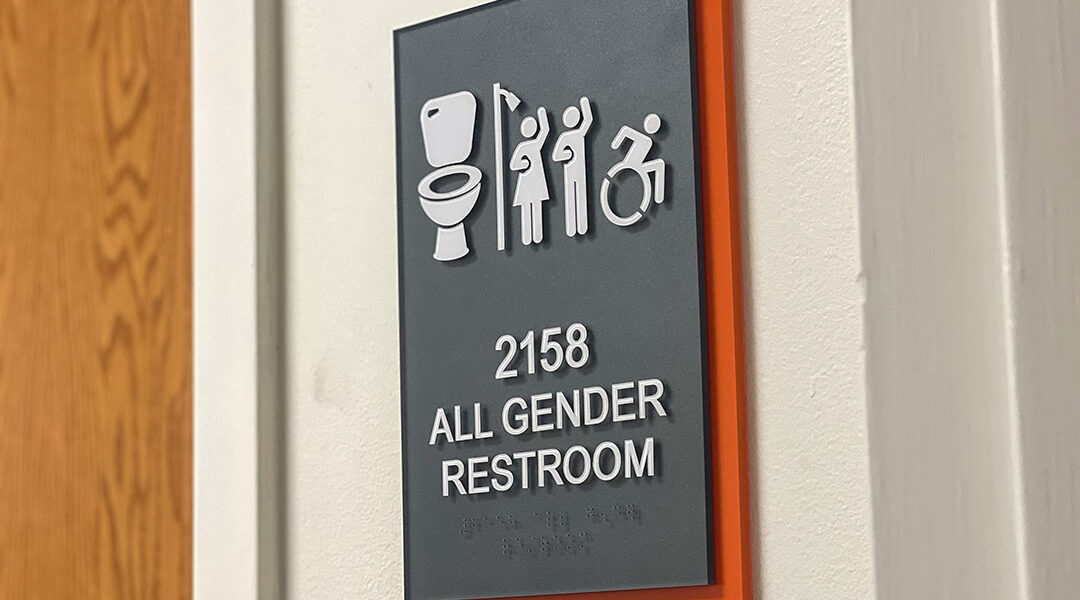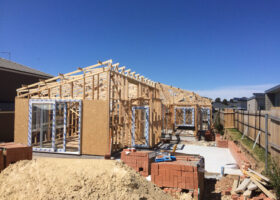The following is an update to a May 2021 article which I wrote titled ‘All-Gender Toilets – We just want to go to the Toilet’.
Go to here to view the original article.
In 2021, I wrote about the provision of All-Gender Toilets and referenced an ABC Opinion piece by Rory Blundell posted on Tuesday 4 April 2017, in which Rory states:
“Like most people who consume almost a litre of soft drink while seeing a movie at the cinema, I really need to pee.
A familiar, prickly feeling of anxiety grows as I try to decide which bathroom I’ll fit in to most. In a moment of panic, I rush into the women’s and beeline for the nearest stall.
Now I just have to make my exit without encountering anyone else.
After 10 minutes waiting in the stall, listening for other people, I decide the coast is clear. Predictably, however, as I’m at the sink, someone enters and stares at me, clearly puzzled.
A part of me is happy that I look masculine enough to confuse people, but mostly I feel deeply uncomfortable, and humiliated by how much attention I’m drawing to myself.
I feel like I’ve betrayed myself, once again, by not feeling able to do something so simple as use the men’s toilet.
I identify as non-binary (or more specifically, trans-masculine), meaning that although I was assigned female at birth, I have never identified as a girl.
Whilst I dress in typically ‘masculine’ clothing and wear a chest binder, I haven’t undergone hormone replacement therapy and often get mis-gendered or mistaken for a girl.
This can make using a public bathroom extremely difficult, as I’m faced with a choice: mis-gender myself and fell like I’m betraying my identify or feel like I don’t quite belong and feel physically unsafe.”
Since 2021, and the research I referenced in my original article, there has been significant ongoing work, research, consultation, information provision and legislative change as well as an ongoing shift in government and community expectations regarding the need for all gender Toilets. As yet, however, all gender toilets have not been mandated as a minimum requirement in any area of the built environment in Australia. Why not, and what is the solution?
Firstly, it is a complex issue due to a significant range of considerations, historical perceptions regarding toilet use, as well as limitations to broad understanding of the differing needs of men, women and the gender diverse community when using toilets. In addition, discussion regarding how people use toilets is not particularly topical or common ‘dinner table’ conversation, but when it is discussed, the issue can be divisive. Think about the broad views on who can/should use accessible toilets?
It is not as simple as change the sign on existing toilets to provide all gender toilets. This is an ill informed and at best a lazy, solution that goes no way to effectively address the broad range of issues and considerations regarding the provision of toilets that meet the needs of everyone. Secondly, it does not acknowledge or accept the relevance of extensive research, consultation and evidence that supports an equitable solution to meet the needs of everyone. Thirdly, it does not meet legislative requirements relating to discrimination or gender equity or support government and community expectations and initiatives in relation to gender equity or the philosophy that everyone has the right to go to the toilet in comfort and safety and dignity.
Philosophy
In simple terms, the philosophical basis for the provision of all gender toilets in public, community, and business spaces aligns with the principles of equity and inclusion. This means that as a community we acknowledge everyone has the right to go to the toilet in comfort and safety and with dignity. This should not be automatically afforded to some sectors of the community and a privilege for others.
Legislation
In Australia there is both Federal and State legislation that aims to protect people from discrimination based on sex and /or gender.
In some states (such as Victoria), there is also the Gender Equity Act 2020. The main purpose of this Act requires the public sector, Councils and universities to take positive action towards achieving workplace gender equality and to promote gender equality in their policies, programs and services.
Both Federal and State legislation apply to elements within the built environment such as toilets.
Some organisations purportedly committed to gender equity have introduced all gender Toilets on a voluntary basis as part of their toilet offerings. Some of these organisations have acknowledged the need for all gender toilets to be provided in addition to mandated male, female, male ambulant, female ambulant and unisex accessible toilets as well as the provision of Accessible Adult Change Facilities and voluntary provision of baby change areas. Some organisations have decided to change the signage on unisex accessible toilets to all gender toilet whilst others have replaced separate male toilets and separate female toilets with all gender Toilets.
There is no consensus regarding the best way to provide all gender toilets, no agreed philosophy or principles or effective usage data upon which provision is based and no consistent approach to design. This creates confusion and uncertainty for both toilet users and building and facility developers.
There are diverse views on the issue, as would be expected in a diverse community, however it is important to look at the facts to try and establish a way forward to begin to meet the fundamental toileting needs of everyone.
Based on extensive research, anecdotal feedback as well as consultations on the issue of toilets and particularly all gender toilets, there is a range of evidence that cannot be ignored and must be considered in any determination regarding provision of all gender toilets and associated facilities. A summary of a range of this evidence and key considerations is provided below.
Provision of Toilets – A Summary of Key Considerations
- Toilet Anxiety and Security
How we feel about going the toilet can impact our emotions and our emotions can impact on going to the toilet.
According to Toiletanxiety.org, toilet anxiety, or toilet phobia, is a term used to describe a number of issues related to using the toilet. It is a type of anxiety disorder in which a person may experience concerns and fears related to being able to urinate or defecate, using a public toilet, being too far from a toilet, having an accident in public, other people being able to hear or see you use the toilet, the cleanliness of public toilets, and/or being confined in a small space as well as fear or embarrassment related to sharing spaces with people of another gender.
Some other reasons for toilet anxiety include:
Gender diversity – members of the gender diverse community often lack access to a safe place to go to the toilet as a person can be ridiculed, abused, threatened or assaulted if they use single gendered toilets. According to Melbourne University, research indicates that ‘Bathroom Anxiety’ is a phenomenon experienced by gender diverse people when an appropriate toilet facility is not provided. This leads to increased levels of anxiety and depression and lower levels of class attendance at the University.
Women – women can feel unsafe, they can be harassed or assaulted or subjected to voyeurism by men, when they are forced to use all gender toilets. Women may also feel that men will disapprove of their natural body emissions that are a natural part of toilet use when forced ot use all gender toilets. Women will sometimes ‘hold on’ rather than use all gender toilets.
Men – men can feel constrained in their interactions with women in an all gender toilet facility. For example, when men and women share a public or workplace all gender facility, men can feel the need to keep their distance in order to ensure a woman does not feel threatened by their presence. They can also feel they must be overly cautious in how they interact with any women when using the facility to ensure they are not accused of what a woman may perceive as inappropriate behaviour, which in fact may just be a natural part of the toileting experience.
Men may also feel that women will disapprove of their natural body emissions that are an integral component of toilet use. Many people are anxious about the idea of sharing toilets with people of other genders, particularly when they need to defecate, due to embarrassment and self-consciousness that can arise during and after the process due to sounds and smell.
As well as issues related to Toilet Anxiety, the issue of toilet security is a major consideration for all toilet users. Toilet security is a crucial factor in access to education, employment and social participation and therefore impacts on a person’s physical and mental health.
Varying social perspectives and perceptions can also impact on the capacity for people to effectively use toilets in public places, including workplaces.
- Culture
Sharing toilets can be a significant cultural issue. Women from a range of religious and cultural groups are not able to use all gender toilets. Modesty, including separation of male and females as well as facilities, is an important consideration for groups such as Muslim and Orthodox Jewish communities, some Australian Indigenous communities and others.
- Health and Hygiene
There is a significant difference in how men, women and members of the gender diverse community use toilets. This can impact on the cleanliness of toilets and the associated impact on the health of toilet users. It also highlights the need for privacy and availability of washbasins and sanitary bins within toilet cubicles or within single gender facilities.
For example, due to the nature of urination by men when standing, it is not uncommon for toilets seats and floors to become wet. This impacts on cleanliness of toilets and the health of toilet users.
Women menstruate and it can be messy. The need to wash soiled clothes and dry them under hand dryers in toilet handwashing areas is not uncommon. The use of menstruation equipment that needs to be washed after toileting is also a hygiene consideration.
Waste left on the floor of toilet cubicles, if sanitary bins are not provided within each cubicle impacts on hygiene. Menstruation also impacts on the amount of time women may need to use toilet facilities compared to men. There is a need for privacy and availability of washbasins in toilet cubicles or within single gender facilities.
One in four pregnancies result in miscarriage. These occurrences create high level trauma and stress situations, particularly if they occur in a public toilet space. There are not only health and hygiene issues associated with these events but also a significant need for privacy.
Some people will use body cleaning equipment after defecating and this may need to be cleaned or disposed of after use. People want privacy wen doing this.
Women and members of the gender diverse community may feel uncomfortable about undertaking personal grooming in shared toilet handwashing areas. This results in people using toilet cubicles to complete these tasks, thus reducing access for users who require use of the toilet pan and are forced to ‘hold on’, creating health issues for people, particularly those with incontinence issues.
‘Holding on’ for extended periods of time can cause health issues such as Urinary Tract Infections and create significant stress.
- Toilet Wait and Use Times
According to the USA ‘Potty Parity’ movement, in busy toilet facilities (for example, theatres), women can wait up to 34 times longer than men to access a toilet. They then spend as much as twice as long in the toilet as men, because they menstruate, have more layers of clothes to remove, must always enter a stall, and are far more likely to have children or older people with them.
Members of the gender diverse community will often ‘hold on’, until the ‘coast is clear’ before darting into a single gender toilet to try and reduce any backlash from male or female users.
Toilet wait times can have a significant impact on people’s health.
Current Status of Toilet Requirements – National Construction Code
The National Construction Code (NCC) currently includes mandated requirements for the provision of the following sanitary facilities based on the classification and occupancy of a building:
- Male
- Female
- Ambulant male
- Ambulant female
- Unisex Accessible
- Accessible Adut Change Facilities.
There is no mandated requirement for the following facilities:
- All gender
- Baby change areas
- Assistance animal relief areas.
Single Gender Toilets
There is convincing evidence to support retention of separate male and female toilets.
This includes issues outlined above such as toilet anxiety, safety, security, privacy, cultural considerations, health and hygiene and comfort.
In addition, there are several factors that support retention of single gender toilets, particularly to meet the needs of women.
Female toilets can provide a safe space for women. This can include situations where a woman may feel harassed or subjected to the unwanted advances, coercion, control or attention of a man. With the development and expansion of online social media platforms, where people meet for the first time online, and then subsequently may meet face to face in public, there are increasing situations where ‘escape’ options are extremely limited should things not progress well during the meeting.
Female toilets are often used as a refuge where a phone call for help can be made or plans for escape can be developed, often in conjunction with other women for support. This of course is also the case for the use of male toilets although anecdotal evidence would suggest this issue is less common for men than women.
Women experiencing psychological or emotional crisis will also often retreat to the female toilets in order for some ‘time out’ as this can afford some privacy.
Women are also often reluctant to use all gender toilet facilities when accompanying young children when using a toilet due to a number of the considerations outlined above, but particularly related to hygiene and safety.
Women often feel uncomfortable about grooming in front of men, which would potentially be the only option in an all gender facility. This would be a particular issue for women where their culture requires their faces to remain covered in front of men.
Single Gender Ambulant Toilets
Ambulant toilets are designed for use by people who may require support on both sides of their body whilst using a toilet pan. For example, this could include a person using crutches or other mobility aid to assist with walking. An ambulant toilet does not meet the needs of a person using a wheelchair. Grabrails are installed on both sides of the toilet cubicle/wall and there is sufficient space at the front of the pan for the person to enter the toilet with a walker or crutches without any encroachment of a door into the space in front of the toilet pan.
In 2019, the NCC introduced requirements for separate male and separate female ambulant toilet facilities to be provided in relevant buildings in addition to male and female toilets. This was based on broad consultation across the community and property sectors. The consultation addressed a range of issues, including many identified as considerations for the retention of single gender male and female ‘standard’ toilets.
Unisex Accessible Toilets
A unisex accessible toilet is typically designed to meet the needs of people who use wheelchairs and others who are blind or have low vision. They incorporate a larger pan circulation space than a standard size or ambulant toilet with sufficient room for a person to transfer from their wheelchair onto the toilet.
In addition, a unisex accessible toilet would be beneficial for a person using toileting equipment, a person with an assistance animal who needs more room, or a person using a pram who requires a larger circulation space and other supports to meet their needs would. In addition, a person who is neurodiverse may need support in understanding and using a toilet, so more room if necessary for two people to be in the same space.
These accessible toilets are currently identified as unisex and re designed to support access for people with disabilities of all genders, as well as carers who may be of a different gender to the toilet user. A more contemporary term would be all gender Accessible toilet or Accessible toilet eliminating the reference to gender, but still identifying the target audience as being people who have access requirements.
Whilst anyone can use a unisex accessible toilet, the attitudes of others can have an impact on whether a person will do so. There is a perception in the community that a unisex accessible toilet should only be used by a person with a disability. There is a good argument for this as there are often not enough of these facilities to cater for the needs of the target group. This is usually because these facilities are only installed to meet minimum compliance requirements, when from a functional perspective it would make more sense to provide increased numbers of accessible toilets so that people who do not have a disability can also feel comfortable in using them for a variety of reasons that do not relate to disability.
Self-appointed ‘toilet police’ will often judge and sometimes abuse users of accessible toilets if they think that the user does not have a disability.
This ill-informed and judgmental behaviour sends a clear message to users that they have some responsibility to prove they are ‘eligible’ to use the toilet.
Being trans or non-binary is not a disability and therefore some people feel uncomfortable about using an accessible toilet, if an all gender toilet is not available, as this is intended for use by people with disabilities. Having to use the accessible toilet on an ongoing basis, (if there is no all gender facility), can incline an individual and society to perceive that a person’s trans or non-binary self-identification is in some way a disabling condition which can impact negatively on an individual’s self-image and reinforce societal stereotypes.
How a person is perceived by others can have considerable influence on their feelings of self-worth and should not be underestimated in terms of the impact on their mental health.
An important consideration from a practical perspective is that the required numbers of unisex accessible toilets in buildings, as per the NCC, is based on the expected usage numbers of people with disabilities. It does not account for additional use by other people. This includes members of the gender diverse community without disabilities, parents with prams, people wanting to change babies or accompany small children. If these additional demands are placed on the limited numbers of unisex accessible toilets, this will significantly reduce the availability of these toilets for the intended target group of people with disabilities.
Accessible Adult Change Facilities (AACF)
Sometimes identified as Changing Places or Change and Lift, these facilities are designed to support toileting for people with high physical support needs. Introduced into the NCC in 2019 they must be designed to meet a significant range of technical dimensions that support the inclusion and operation of the following elements:
- permanently installed height adjustable adult-sized changing bench
- constant charge in-line room coverage tracking hoist system
- adequate space in the changing area for the user and up to two carers
- a centrally placed toilet with room either side for the carers
- a screen or curtain to allow the user and carer some privacy
- a dispenser for sanitary wipes
- a non-slip floor
If a person with high physical support needs does not have access to an AACF they may need to be changed on the floor of an accessible toilet, which is abhorrent, undignified and unhygienic.
The provision of these facilities is mandated in large buildings depending on the size and occupancy. These buildings include sports venues, swimming pools, museums, art galleries, theatres and airport terminals.
AACF facilities cannot replace a unisex accessible toilet as the requirement for a ‘peninsula’ type toilet pan, that can be accessed from both sides if required, is different to that required in an accessible toilet facility.
All Gender Toilets
All gender toilets are facilities that can be used by everyone regardless of gender identification or determination. They do not have gendered signage, and do not require the person using them to define into a gender.
Installation of all gender toilets, in addition to other types of toilets such as single gender toilets i.e. male and female toilets, unisex accessible toilets, ambulant toilets, accessible adult change facilities, baby change facilities and assistance animal relief areas, support the principles of access and inclusion. They provide the opportunity for people to make choices about which toilet they may need or prefer to use based on their individual requirements.
Extensive consultation has identified that the term ‘All gender’ is preferred to ‘Gender- Neutral’ or ‘Unisex’ and is the most inclusive of the broad spectrum of gender.
All gender toilets are not yet a mandatory requirement under the NCC. However, the Australian Building Codes Board (ABCB) has undertaken a Public Consultation in relation to a proposed amendment to the NCC regarding the introduction of All gender toilets, initially as a voluntary provision in the NCC.
The NCC 2022, clause F4P1 Personal hygiene facilities states:
Suitable sanitary facilities for personal hygiene must be provided in a convenient location within or associated with a building, to the degree necessary, appropriate to-
-
- The function or use of the building; and
- The number and gender of the occupants; and
- The disability or other particular needs of the occupants.
The ABCB Consultation Background, states:
Although the current clauses could be read as stipulating the need for bathrooms to suit gender-diverse people or the needs of gender-diverse occupants, the Deemed to Satisfy provisions do not include a suitable mechanism to provide all gender facilities.
Under the current Deemed to Satisfy provisions toilets are designated female, male or unisex accessible. As such, all gender facilities could only be provided in addition to the existing minimums; or a performance solution would need be developed to enable alternate allocation of facilities. Both options incur additional project costs.
Given that a Performance Solution must be equal to or greater than the Deemed to Satisfy provisions in the NCC, it would be almost impossible to justify this based on the wide range of considerations relating to toilet access and usage outlined previously.
The ABCB Proposed amendment to the NCC also proposes the use of updated and consistent language in reference to sanitary facilities and states that updating the
NCC to use the consistent language of ‘gender’ and ‘accessible’ is more inclusive. This removes reference to ‘sex’ or ‘unisex’.
The term ‘all gender’ is more broadly representative of the gender diverse community rather than terms such as ‘gender neutral’ or ‘unisex’. Both of these terms can be interpreted as lacking awareness and somewhat offensive, as they do not acknowledge the rights of self determination regarding gender identification. In simple terms – sex relates to biological determination, whereas gender relates to self and cultural determination.
There is no proposal regarding use of specific symbols. It is important that that an appropriate and consistent approach is developed and adopted.
ABCB Rationale for the proposed changes to the NCC (Section F)
The ABCB Rationale for the proposed changes to the NCC (Section F) is as follows:
Improving inclusivity: gendered bathrooms are exclusionary and discomforting for transgender, non-binary, intersex, and other gender-diverse people. all gender bathrooms create safer spaces that are inclusive to individuals of all gender identities. This fosters an environment that respects and affirms the dignity of all people, regardless of their gender identity.
Additional benefits: improved access to bathrooms for people with medical conditions who may require access to a WC and handbasin within a private cubicle and parents with young children of a different gender. It also provides an option for additional bathrooms when there is a high volume of bathroom use.
Red tape reduction: introduction of a new Deemed to Satisfy pathway will remove the time and cost associated with developing and assessing a performance solution.
Voluntary and cost effective: a voluntary solution with no change in stringency (i.e. no overall increase in the quantum of facilities required), reflecting modern architectural practice, will remain close to the current project cost profile for the provision of sanitary facilities.
Privacy and safety: all gender facilities provide a private and safe space for individuals who may feel uncomfortable or unsafe in gender segregated facilities.
Maintaining accessibility: providing dedicated all gender facilities will reduce reliance on unisex accessible facilities, thereby maintaining the intended level of access for people with disability to use suitable sanitary facilities.
Gender diversity awareness and acceptance: all gender bathrooms help broaden community awareness, understanding and acceptance of diverse gender identities.
ABCB Rationale for the proposed change in terminology from ‘sex’ to ‘gender’
The ABCB Rationale for the proposed change in terminology from ‘sex’ to ‘gender’ is as follows:
Improving inclusivity: the term ‘gender’ is more encompassing and recognises a spectrum of identities beyond binary male and female.
Gender diversity acceptance: use of ‘gender’ acknowledges and respects diverse gender identities.
Contemporary language: the term ‘gender’ is increasingly used, recognising individuals according to their self-defined identity.
Whilst the results of the Public Consultation are yet to be analysed, along with a decision by the ABCB regarding the introduction of the voluntary provision in the NCC, the initiation of this proposed amendment and the consultation process have highlighted growing government and community expectations that we must act on, not just discuss how to meet the toileting needs of everyone in the community, if in fact we are to support and develop an equitable and inclusive community.
An Equitable Way Forward
An equitable and inclusive way forward regarding toilet provision must be based on acknowledgement and acceptance of the following:
- Commitment to the philosophy that everyone has the right to go to the toilet in comfort and safety and with dignity.
- Legislation confirmation and direction based on requirements for equity, inclusion and anti-discriminatory practice.
- Recognition and acceptance of the wide range of issues that must be considered in provision of toileting options for everyone including considerations relating to:
- comfort
- cultural considerations
- health and hygiene
- privacy
- specific needs of different user groups
- toilet access and wait times
- toilet safety and security
- The existing requirements for provision of toilets already established in the NCC.
What is Equitable?
Equity requires that all gender toilets be introduced as a mandatory requirement in buildings and facilities used by the public. All gender toilets should be provided in addition to the existing provision for other toilets currently mandated by the NCC.
Furthermore, an equitable approach would require the provision of all gender toilets to be based, at a minimum, on the dimensional requirements for ambulant toilets in the NCC, and in addition include a washbasin, shelf, mirror and sanitary bin. (An example of this type of facility can be found in the Specialist Disability Accommodation (SDA) Design Standard Figure 7 (h) Design Option 1 and figure 7 (i) Design Option 3.)
Introducing this solution from an equity perspective, based on existing NCC toilet requirements, would mean a range of functional outcomes would be achieved for everyone. It would also address many of the identified issues and considerations relating to the provision of toilets for everyone.
This solution would build on the current mandatory provisions for toilets in buildings and facilities where toilets are required, and therefore include male, female, male ambulant, female ambulant, all gender and all gender ambulant (all in one), and accessible and accessible adult change facility.
From a functional perspective:
Men would be provided with access to male toilets, male ambulant toilets, accessible toilets, accessible adult change facilities.
Women would be provided with access to female toilets, female ambulant toilets, accessible toilets, accessible adult change facilities.
The gender diverse community would be provided with access to all gender toilets, all gender ambulant toilets (all in one), accessible toilets, accessible adult change facilities.
People with disabilities of any gender would be provided with access to accessible toilets, male ambulant toilets, female ambulant toilets, all gender ambulant toilet and accessible adult change facilities.
This solution does not however address the toileting needs of babies, young children or parents with prams, which should also be addressed in a separate review.
Analysis of the Proposed Amendment to the NCC
The proposed amendment to the NCC is a starting point for change as it acknowledges there is a need for the provision of all gender toilets.
However, the proposed amendment is very limited in its application in that:
- It does not support mandatory provision of all gender toilets. Proposed changes would be implemented on a voluntary basis and therefore there is no guarantee that suitable all gender facilities would be provided in any building.
- It allows for the replacement of all separate male and female toilets with all gender toilets is some buildings. This ignores the significant research that provides evidence that this is an inadequate and inappropriate solution. Replacing single gender toilets with all gender toilets does not address social, cultural, religious, psychological and practical and safety considerations for women and men. For example, it eliminates access to toilets for some religious and cultural groups.
- It allows for rebadging of toilets in some buildings that are is only required to be provided with three closet pans or urinals. One of these can be rebadged as an all gender toilet. This assumes the existing design of the toilets appropriately addresses the privacy, cultural other relevant considerations associated with toilet provision for everyone.
- It allows for the redistribution of existing male and female toilets on an equal basis in some buildings to provide all gender toilets. This ignores the significant research that provides evidence that this is an inadequate and inappropriate solution. It reduces access to toilets for women who are already discriminated against due to inequity in toilet provision related to differences in how and why men and women use toilets as well as the inequities in toilet use wait times.
- It does not address the basic minimum construction or dimensional requirements for all gender toilets to meet the needs of the gender diverse community, specifically relating to privacy and safety, such as wall heights, gaps under/over toilet doors, locking mechanisms etc as well as functional considerations such as the provision of a urinal, handbasin, shelf, mirror and sanitary bin in the toilet cubicle.
Toilet Design Considerations
Further research is required to resolve the design conflicts in toilet provision, including the conflicts between practical design solutions and the experiences of toilet users.
Appropriate toilet design is critical in addressing the vast array of issues related to safe, hygienic, equitable and dignified toilet use. Applying the principles of Universal Design provides a framework for practical considerations for everyone, however considering the goals of Universal Design i.e. Body fit, Comfort, Awareness, Understanding, Wellness, Social integration, Personalisation, Cultural appropriateness provides better outcomes for everyone. Universal Design does not mean that providing the same toilet for everyone to use is the solution. Innovative design solutions need to be considered in the context of specific user groups and their identified needs.
It will be necessary to develop design solutions that are appropriate for a variety of building types, sizes and uses as well as social contexts, as meeting the needs of everyone will vary across different building uses and occupants.
A range of design considerations include:
- Fixtures and fittings
- Hygiene nd maintenance
- Location
- Privacy
- Safety
- Security
- Signage and wayfinding
- Size
- User comfort.
Cost
There is no doubt that there could be a cost impost for adding toilets to buildings and facilities. However, the existing required numbers of toilets required in buildings should be reviewed to ensure that equitable provision of toilets for everyone is achieved. Basing required numbers of toilets on gender segregation does not work for many reasons outlined in this document. In addition, provision of accessible toilets based on expected user numbers of people with disabilities, does not work. Accessible toilets are often used by people without disabilities and often baby change facilities are installed in these spaces reducing or in fact eliminating use by people with disabilities, (particularly if baby change tables are left in the down position and a person cannot lift them back up against the wall to access the toilet pan).
The provision of all gender toilets should also be considered in the calculation of required toilet numbers, based on sound research that provides data to support effective outcomes.
The result of this type of research in fact may not lead to significant cost impost across buildings but may result in redistribution of toilets in a more equitable manner based on user need.
Any potential cost impost could be offset by the potential future proofing of a building against possible changes to the NCC for mandated all gender facilities in the future. This is inevitable for compliance with legislation such as State and Federal Sex Discrimination and Gender Equity Acts. In addition, community expectations and government policy relating to community inclusion will also influence the introduction of mandated requirements in the NCC.
The potential upfront cost impost of providing all gender toilets will also be reduced by eliminating the likelihood of a complaint being made under the relevant discrimination legislation, by a member of the gender diverse community who believes they have been discriminated against due to the lack of appropriate toilet facilities.
Cost impost will need to be addressed in the same way as the cost of accessible toilets was addressed and the cost of accessible adult change facilities was addressed by developers, when these were introduced into the NCC.
It we are committed to an inclusive society, the investment in additional all gender toilets will be realised by the long-lasting effects on community, social, and economic participation, education and workforce engagement and improvements to mental health. The positive impacts of these outcomes are well documented.
We must continue to progress and work toward toilet equity for everyone.
To quote Liz Ellis, a social worker who is a strong advocate for Changing Places facilities, – It should be a right to go to the toilet, not a privilege. I would add – in safety, comfort and with dignity.
References
Equal Opportunity Commission of Western Australia with assistance from Curtin University – 2022- Changing rooms for gender diversity- An issues paper regarding gender identify discrimination in public facilities https://www.wa.gov.au/government/publications/changing-rooms-gender-diversity
Pinsker, J – 2019 -The Long Lines for Women’s Bathrooms Could Be Eliminated. Why haven’t they been? https://www.theatlantic.com/family/archive/2019/01/women-men-bathroom-lines-wait/580993/
Lawford-Smith, H – 2019 – Should companies install gender neutral bathrooms? https://hollylawford-smith.org/should-companies-install-gender-neutral-bathrooms/
Cox, A 2023- Parlour – All gender bathrooms campaign
https://parlour.org.au/advocacy-and-action/ncc-all-gender-bathrooms-campaign/
NDIS – Specialist Disability Design Standard 2019
Vigneau, A., Hillebrand, C., & Pettigrew, C. (2023). All-gender restrooms: Embracing change in the built environment.
https://doi.org/10.52499/2023018.
Australian Building Codes Board – 2023 – All-gender sanitary facilities – Public Consultation
Disability (Access to Premises – Buildings) Standards 2010
Australian Standard AS1428.1 2009 – Design for Access and Mobiity – Part 1: General requirements for access- new building work
Transport New South Wales 2021- Customer Strategy and Experience Design – Toilet Guideline for Transport NSW
Manton, J. – 2021- All-Gender Toilets – We just want to go to the Toilet.
https://accessinstitute.com.au/all-gender-toilets-we-just-want-to-go-to-the-toilet/
Gender Equity Act Victoria 2020











Join the conversion
Don't:
Do:
Diarmuid Hannigan
30/07/ 2024
Thank you for bringing this topic up for discussion. Recently I visited Vic Roads in Carlton Melbourne. I noticed they had closed their public access toilet. Note Vic Roads in Carlton a very busy place where people have to wait for long periods of time to get their car registration and licencing details processed. There are no public toilets close to this facility. I contacted the Melbourne City Council about the issue and was firmly informed that because it was a State Government facility it was not within their jurisdiction and therefore could not act!
Grant Spork
30/07/ 2024
To this excellent piece I would like to make additional suggestions and comments.
Stadiums and Sports complexes should not be required to have all non gendered toilets, The space requirements would mean no complex would ever be built.
if you go to a major stadium it is clear that more female and non gendered facilities are required. I would limit non gendered toilets to 10% and keep the existing requirements.
brisbane is preparing for an Olympics and I would like to point out.
Public toilets in the CBD and near every proposed venue are appalling. often toilets are not designed to be washed down with a pressure hose and they should be.
Queensland has a major problem with facilities in parks, National PArks and on freeways, most of the public toilets including at service stations are a health hazard and third world quality. We need legislation to ensure these toilets and facilities are regularly cleaned and a huge fine when they are not. it is a condition of having any license. Then there are beachside facilities in Qld sometimes exceptional but many need to be upgraded. if we are going to have hundreds of thousands of tourists every pub and venue needs to get up to standard starting now. Frankly public toilets and in pubs and clubs are an absolute disgusting disgrace. Similarly our airports, train stations, taxi ranks, absolutely disgusting and must be rejuvenated.